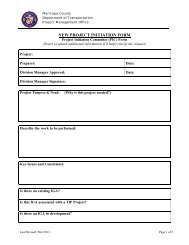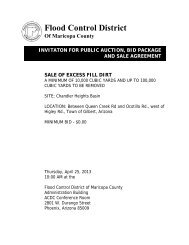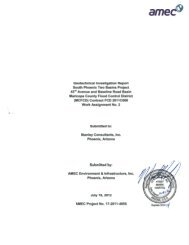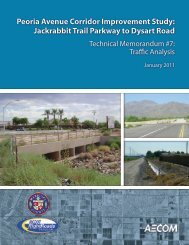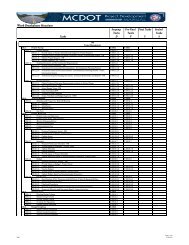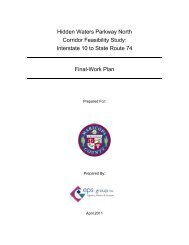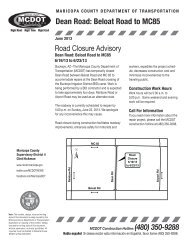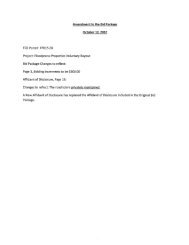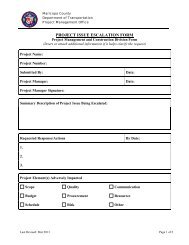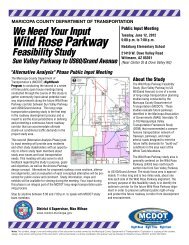Drainage Overview - Maricopa County Department of Transportation
Drainage Overview - Maricopa County Department of Transportation
Drainage Overview - Maricopa County Department of Transportation
Create successful ePaper yourself
Turn your PDF publications into a flip-book with our unique Google optimized e-Paper software.
Normal depth (Modified Puls) channel routing methodology was used to route run<strong>of</strong>f<br />
through subbasins. An eight-point composite channel cross-section was estimated from 10ft<br />
topography, aerial photography, and field observations to represent typical wash crosssection<br />
conveyance. Reservoir routing was performed upstream <strong>of</strong> the CAP canal using<br />
stage-storage data from the Wagner Wash Floodplain Delineation Study Hydrology Report.<br />
Flow diversions were estimated as simple percentages for the entire range <strong>of</strong> discharges<br />
using the 10-ft topography, aerial photography, and field observations. Retention from the<br />
100-year, 2-hour storm event was diverted out <strong>of</strong> the future land use conditions models.<br />
4.1.2 Wittmann Watershed<br />
This watershed was divided into eight major sub-watersheds, four <strong>of</strong> which encompass the<br />
Deer Valley Parkway study area: the Sun Valley Parkway, Iona Wash, Trilby Wash, and<br />
Wittmann Wash sub-watersheds. The 100-year, 6-hour and 24-hour storm events for both<br />
the existing and ultimate development land use conditions were modeled using HEC-1<br />
s<strong>of</strong>tware. Methods and procedures were based on the FCDMC Hydrology Manual.<br />
Watershed Modeling System (WMS) s<strong>of</strong>tware was used to prepare the input parameters for<br />
the HEC-1 models.<br />
NOAA Atlas 2 rainfall data was used to estimate the design rainfall depth for this study.<br />
Depth-area reduction factors were applied with the use <strong>of</strong> JD records. FCDMC 6-hour local<br />
storm distributions for the 6-hour model and the SCS Type II precipitation distribution for<br />
the 24-hour model were used for HEC-1 rainfall distributions. The Green and Ampt Method<br />
was utilized for the estimation <strong>of</strong> rainfall losses. The Clark Unit Hydrograph was used for<br />
the development <strong>of</strong> unit hydrographs.<br />
Normal depth channel routing methodology was utilized in the hydrologic model to route<br />
surface run<strong>of</strong>f through subbasins. An eight-point composite channel cross-section was<br />
developed to represent typical wash cross-section conveyance. The longitudinal slopes and<br />
Manning’s “n” values were estimated based on topographic mapping, aerial photographs,<br />
and field reconnaissance estimates. Storage routing behind the CAP canal was modeled<br />
using level pool routing. Stage/discharge relationships for the over-chutes were developed<br />
assuming critical flow through the structure. Normal depth calculations were used to<br />
calculate most <strong>of</strong> the flow splits, although two-dimensional analyses were conducted for<br />
four complex split flow locations. Three <strong>of</strong> those split flow locations are in the Iona Wash<br />
sub-watershed upstream <strong>of</strong> the CAP canal. The fourth split flow is located north <strong>of</strong> the<br />
CAP canal and east <strong>of</strong> US 60. All four <strong>of</strong> the split flows modeled with two-dimensional<br />
analysis are located upstream <strong>of</strong> the study area. As mentioned in Section 3.4.1, there are<br />
additional areas within the Wittmann watershed that may require two-dimensional modeling<br />
due to the lack <strong>of</strong> identifiable drainage patterns.<br />
4.1.3 McMicken Dam Watershed<br />
Hydrologic modeling <strong>of</strong> the watershed contributing to McMicken Dam was conducted to<br />
assess flows entering the dam at key inflow locations. Therefore, although the watershed is<br />
very similar to the Wittmann Watershed, the subbasins are much larger. WMS s<strong>of</strong>tware<br />
was used to calculate run<strong>of</strong>f for the 100-, 200-, and 500-year, 24-hour storm events for both<br />
existing and future land use conditions. The 6-hour and 72-hour Probably Maximum Flood<br />
091337137, 2011-018, TT005 <strong>Maricopa</strong> <strong>County</strong> <strong>Department</strong> <strong>of</strong> <strong>Transportation</strong><br />
Technical Memorandum 3 Deer Valley Parkway Feasibility Study<br />
<strong>Drainage</strong> <strong>Overview</strong> 22 April 2012





